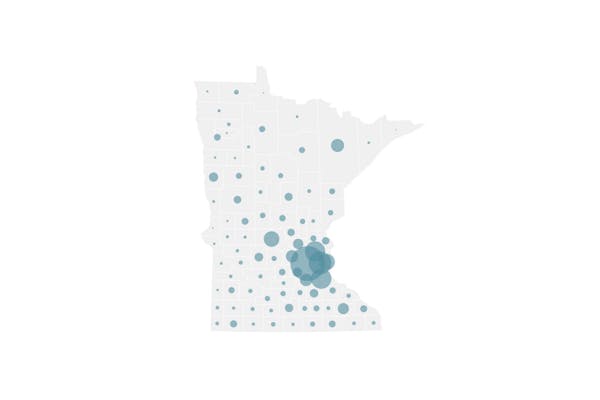Ninety-two more COVID-19 deaths and 2,279 newly confirmed infections were reported Wednesday by Minnesota health authorities, who credited a decline in the pandemic wave to compliance with mask-wearing, social distancing and a four-week order that closed restaurants and discouraged group gatherings.
Daily infection numbers were already dropping before the four-week pause, but Gov. Tim Walz said that the order helped maintain that trend and buy Minnesota time until a COVID-19 vaccine can be broadly distributed.
"The pause that we took three weeks ago has made a difference," Walz said on Tuesday after witnessing the first COVID-19 vaccination of a nurse at the Minneapolis VA Medical Center.
The daily COVID-19 new infection rate, based on a seven-day rolling average, peaked at 124 per 100,000 residents on Nov. 11 and declined to 119 on Nov. 20 when the order took effect, according to the state's pandemic dashboard. The rate has now dropped below 80.
At least 386,412 Minnesotans have tested positive since the start of the pandemic in March for the novel coronavirus that causes COVID-19, and 4,575 have died from the infectious disease.
The latest pandemic wave has shown watch-like precision, as predictions by state leaders came true that a peak of infections would be followed in two to three weeks by a surge of hospitalizations and then a spike in deaths.
Wednesday's reported death total was one of the highest in the pandemic — and included 37 people who lived in private residences, one jail inmate and 54 people who lived in long-term care or assisted-living facilities.
More than 65% of COVID-19 deaths in Minnesota have involved residents of long-term care, who are at greater risk due to their ages and underlying health conditions. However, that rate was more than 80% earlier in the spring, and the decline underscores the continued spread of COVID-19 to vulnerable populations outside of these facilities.
Minnesota's hospitals showed peak activity on Dec. 1 — three weeks after the peak in infections — when 399 COVID-19 patients occupied more than a quarter of available intensive care beds in the state. The number of COVID-19 ICU patients dropped to 304 on Tuesday.
Minnesotans deserve credit for buckling down through Thanksgiving and limiting gatherings to smaller groups to reduce viral transmission, said Dr. Mark Sannes, an infectious disease specialist with HealthPartners, which has seen its COVID-19 hospitalizations in ICU and non-ICU beds drop from 224 on Nov. 24 to 151 on Tuesday.
The share of Minnesotans who wear masks most or all the time in public has increased from 86% in September to more than 94% now — with even greater gains in rural counties, according to survey data reported by Carnegie Mellon University's COVIDcast.
"The question we have been asking for the past week is, are we going to see a post-Thanksgiving weekend surge, much as folks are seeing in many states around the country?" Sannes said. "We have not seen that in Minnesota, and in fact we've been steadily declining during the time when we would have expected that to bump back up."
The fall COVID-19 wave started with surging infection rates in the four states bordering Minnesota before numbers started to increase here. While infection numbers have declined in the Upper Midwest, the pandemic wave is radiating outward through the rest of the country. States such as California, Pennsylvania and Tennessee are reporting their highest infection rates in the pandemic.
State leaders said they are hoping that COVID-19 death numbers in Minnesota will follow the trend of infections and hospitalizations and start to decline as well. However, Wednesday's total makes the past week the deadliest in the pandemic for Minnesota. The state reported 466 COVID-19 deaths in the seven-day period ending Wednesday.
Jeremy Olson • 612-673-7744

In Grand Rapids, Itasca Pride is planning its first event, but there is already pushback
One person shot at YMCA in Coon Rapids

BCA says man pointed pistol-style BB gun at officers before he was shot in Woodbury

Former diversity worker sues University of Minnesota after firing over swastika photo

